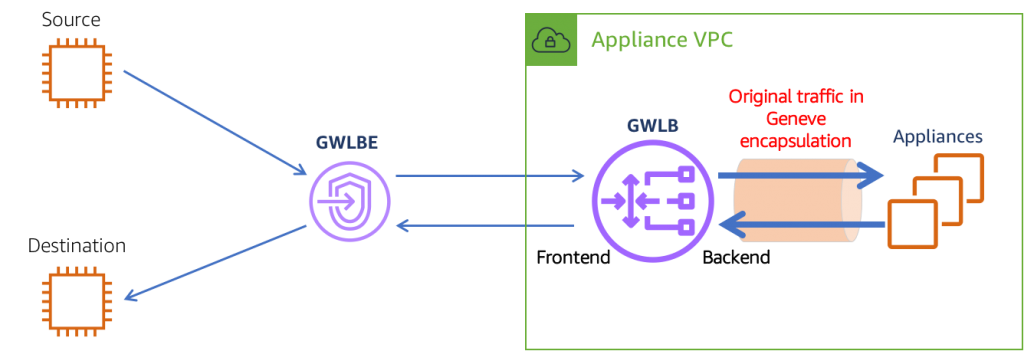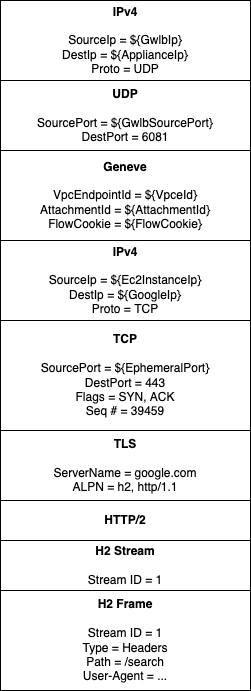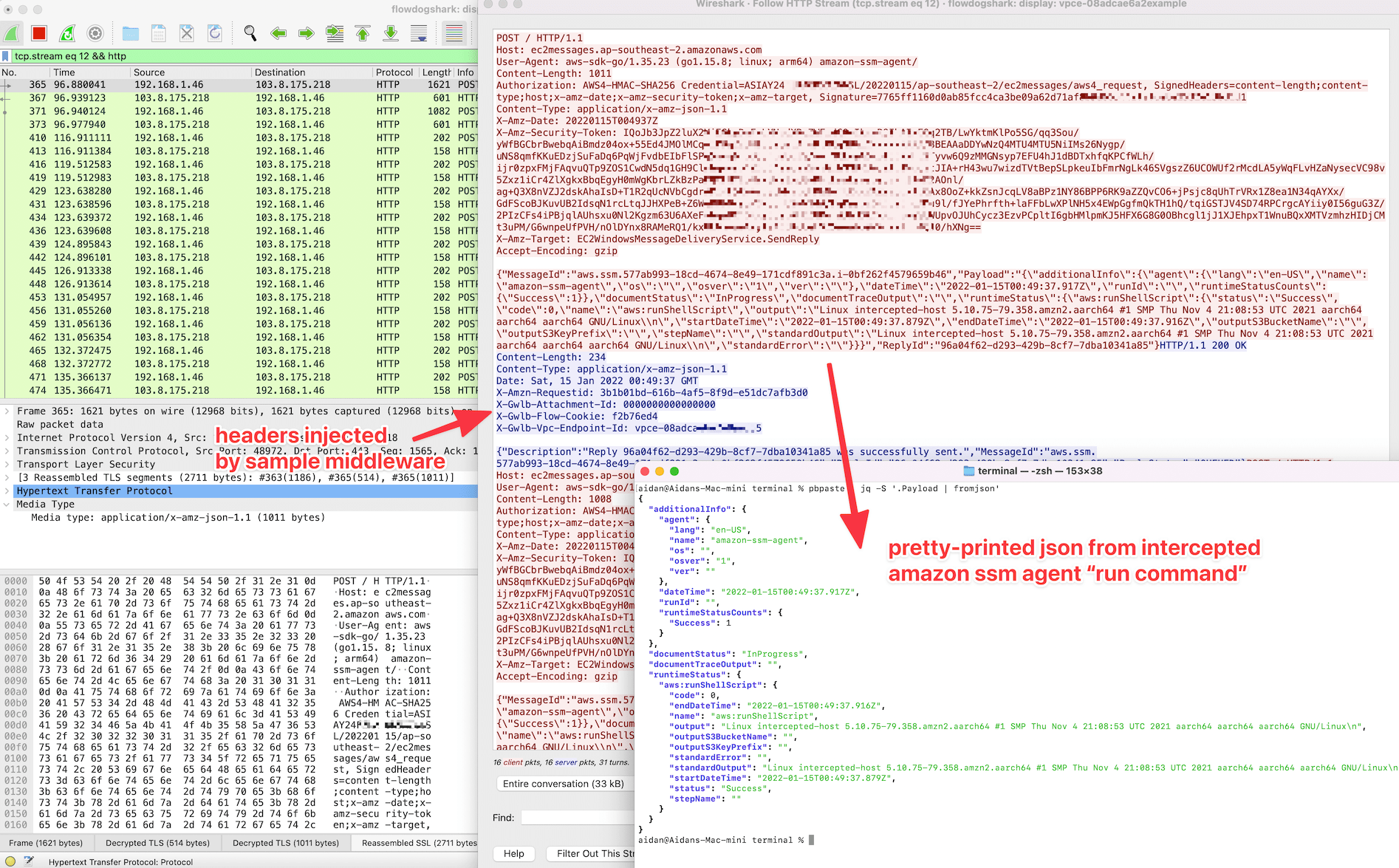AWS GWLB: Deep Packet Manipulation
AWS introduced Gateway Load Balancers back in November 2020. A reasonably accurate tl;dr would be that they are like having highly available, auto-scaling NAT instances. That intro blog post will explain them better than I can.
The blog post mentions a dozen AWS partners that implement various flavours of firewalls, deep packet inspection, DDoS protection, etc. It's all useful and serves a genuine need, but not very exciting from a developer perspective.
There's been a real dearth of community blog posts about it in the subsequent years. There's the GeneveProxy post by Luc van Donkersgoed, which does a really great job of explaining how the GWLB works and how to build a sample app for it, but that's about it. I suspect it's because going beyond a simple packet-by-packet model explodes in complexity. If you are more interested in the demos than why it's hard, you can skip to the bottom. Otherwise, I'll try explain:
The complexity¶
GWLBs aren't hard themselves, look at this diagram (from Amazon's blog post):

It's inspecting and modifying network traffic in general that is extremely
difficult. Especially non-trivial modifications. Take the following diagram as
an example. This is just one packet in a flow of packets between an EC2
instance and the Internet when curl https://google.com is run.

You can think of this packet as having many layers. Each layer "wraps" the layer below it. The bottom six layers were sent by the EC2 instance. The top three layers are GWLB-specific. They identify which VPC endpoint (e.g. customer) the packet came from and which "flow" of packets this particular packet belongs to.
Say we want to change all web requests to google.com to have the User-Agent
request header instead be lower-case, e.g. user-agent. This would require us to
parse the formats for:
- The inner IPv4 layer, to identify is this a TCP packet
- The TCP layer, to identify if the destination port is 80 or 443
- The TLS layer, to (magically, for now) decrypt the payload
- The HTTP/2 layer, to inspect the multiplexed streams within
- The frames in each HTTP/2 stream, to identify if they are a
HEADERSframe. - The headers in the HTTP/2 frame, to see if the
User-Agentheader is present.
Finally we would have to edit the packet in memory at the right offset to change
U to u and A to a, correct the checksums at every layer of the packet
and re-encrypt the TLS payload. That's a lot of work.
And that's a trivial change: the packet length hasn't changed. Imagine if wanted to insert a few additional headers in that request. Maybe that would push the packet length over the typical 1500 byte limit for packets on the Internet. That increases the amount of work needed by orders of magnitude: now we need to reimplement the TCP state machine, because we'll now need two packets. And those packets each need sequence numbers. But the original EC2 instance will get a response from Google for sequence numbers it didn't expect, so the connection will fail. So what we need to do is instead terminate the TCP connection at the GWLB appliance and open a new connection to Google from the GWLB appliance. The app will need to juggle these two TCP connections and pass the underlying data to and from Google and the EC2 instance, all while keeping the two connection's different states in sync.
That's so much work that it's no wonder that even after more than a year, only massive well-funded vendors have implemented this capability. And even then, it looks like they're limited to either read-only inspection or dropping suspicious packets.
A solution¶
I've come up with a handful of demo applications, only made possible thanks to some fantastic open source software. Specifically:
-
inet.af/netstack: a reimplementation of the entire Linux TCP/IP stack in Go, extracted from the gVisor project. -
github.com/google/gopacketto extract and parse the Geneve, IP, TCP, UDP, etc layers from the raw packets delivered by the GWLB. -
httputilin the Go stdlib, to reverse-proxy HTTP and HTTPS traffic and parse flows into individual request and response objects. -
github.com/aws/aws-sdk-goto use AWS KMS asymmetric keys for the root certificate authority that can be installed on EC2 instances for transparent TLS decryption - without having to manage a highly-sensitive private key. -
rogchap.com/v8goto embed the V8 JavaScript engine into Go, so that we can write scripts to modify traffic in JS, which is more familiar than Go to many developers.
Example use cases¶
These are really just intended to demonstrate that anything is possible in the world of software-defined networking. Please ping me on Twitter with any cool ideas you have. Or any enhancements to the following ideas.
lambda_acceptor/lambda_acceptor.gotakes the idea of AWS API Gateway Lambda authorizers and applies it to VPC flows. At the start of every new connection, a Lambda function is invoked and returns a decision about whether to allow or drop the connection. It's like security groups 2.0. Input/output looks like this:

flowdogshark/flowdogshark.gois anextcapplugin for Wireshark that allows you to live-attach Wireshark to flowdog and capture traffic flowing through your VPC. Given that flowdog does TLS interception (see later section in README), it can even use Wireshark's support for decoding TLS. Here's an example of intercepting the Amazon SSM agent:

-
account_id_emf/account_id_emf.gois an example of scanning all AWS API calls made within the VPC for SigV4 auth headers, extracting the AWS account ID and emitting it to CloudWatch via specially-formatted logs that are turned into metrics. This could be used to alert on newly-seen account IDs: a potential indicator of a compromised instance. -
upsidedown/upsidedown.gois an implementation of the classic Upside-Down-Ternet. It blurs and rotates every image 180º when browsing the net.

sts_rickroll/sts_rickroll.gois another silly example. Here we are modifying the response of the AWS API call foraws sts get-caller-identityto return something unexpected. You could equally use the same logic to return your favourite video on every seventh object downloaded through an S3 VPC gateway.

-
gwlb/websocket.gois not an example, but I got lazy. Nick Frichette had the great suggestion of intercepting the SSM agent for shenanigans. This code will detect websockets and parse messages, but right now only passes them back and forth. Soon™. -
cloudfront_functions/rick.jsis an example of how the CloudFront Functions event model can be applied to rewriting HTTP(S) requests inside a VPC. In this particular example, we're ensuring that any AWS Workspaces users visiting YouTube can only watch one particular video. Code:
function onRequest(event) {
const r = event.request;
if (r.headers.host.value !== "www.youtube.com") {
return r;
}
const onlyVideoOnYoutube = "https://www.youtube.com/watch?v=dQw4w9WgXcQ";
const referer = r.headers.referer;
if (referer && referer.value === onlyVideoOnYoutube) {
return r;
}
if (r.uri === "/watch" && r.querystring.v.value === "dQw4w9WgXcQ") {
return r;
}
return {
statusCode: 302,
statusDescription: 'Found',
headers: {
location: { value: onlyVideoOnYoutube }
}
};
}
Bonus: TLS¶
We haven't broken TLS. For this app, we create a custom root certificate authority
and add it to the trust store on our EC2 instances. Rather than deal in sensitive
private key material, we use AWS KMS' support for asymmetric keys for our
private key. generate.go creates a certificate
using that key. That certificate is then stored and trusted on the OS (e.g. in
Amazon Linux 2 you would run cat $CERT >> /usr/share/pki/ca-trust-source/anchors/lol.pem && update-ca-trust)
Rather than invoking KMS on every TLS connection, on launch this app creates an ephemeral key pair and certificate in memory, asks KMS to sign it and then uses that as an intermediate certificate authority. This means we can have fast TLS de/re-encryption with no stored secrets.
When Wireshark is attached, flowdog can stream TLS key logs in NSS Key Log Format. This allows the Wireshark user to view all decrypted TLS traffic without giving away either the KMS private key (impossible) or intermediate CA private key (very unwise).